















Download prideflags.d64
(Please note that the C64 does not have enough colors to produce some flags, including the popular Lesbian flag stripes.)

















Download prideflags.d64
(Please note that the C64 does not have enough colors to produce some flags, including the popular Lesbian flag stripes.)
As you may know, I’m a collector of video games. All systems, all eras. I I like picking up asexual-adjacent games, like “Ace Attorney”, “Ace Combat”, “Ace of Aces”, “Cake Mania”, and “Dragon Warrior”. However, some of my most favorite pieces in the collection are the ones I had to import from an alternate dimension because they don’t exist in our universe. That brings me to the game I want to talk about today.
It’s late October 1987. Fatal Attraction and The Princess Bride are on top of the box office, Michael Jackson’s Bad is tearing up the charts, and millions of people are tuning into Cheers and Night Court every week. And Terrace Spring Publishing is about to release their first ever video game.
Terrace Spring knows nothing about the video game market. They do books. Their most popular series is the “Celebrate Your Own Identity” line of multiple-choice books. But, like many other companies in the late 80’s, they see an opportunity in the emerging world of video games. They hope to cross-promote, making games from their most popular books, and eventually making books based on their games.
But the investors are nervous. The Video Game Crash of 1983 is still fresh in the minds of their account balances, and a bad game could tank sales for the related book, and could bring the whole company down. And so, they strike a compromise: Terrace Spring can get into the video game world, but they have to start out with a low risk, unknown property. If it fails, they quietly sweep it under the rug and go back to books, but if it succeeds, it’s full steam ahead on this new strategy.
And so, Ace Blackring was born.
My first encounter with Ace Blackring was in an eBay auction for video game ephemera. I like collecting the odds-and-ends of the video game industry. I have stuff like sales materials for terrible Mythicon Atari games, advertising mockups for Vexx, printing separations for Sam & Max, and a bunch of those box art cards that used to be in the flip up pouches they had in Toys R Us. I love that kind of stuff, because it’s so odd. Everyone has a copy of Sonic the Hedgehog, but how many people have a promotional poster for the Vectrex?
I came across the eBay profile of someone who claimed to be the manager of the Waldenbooks in Bellis Fair Mall in the mid-to-late 80’s. They had all sorts of great stuff, but I immediately forgot all about everything else they had when I cast my eyes upon this treasure…
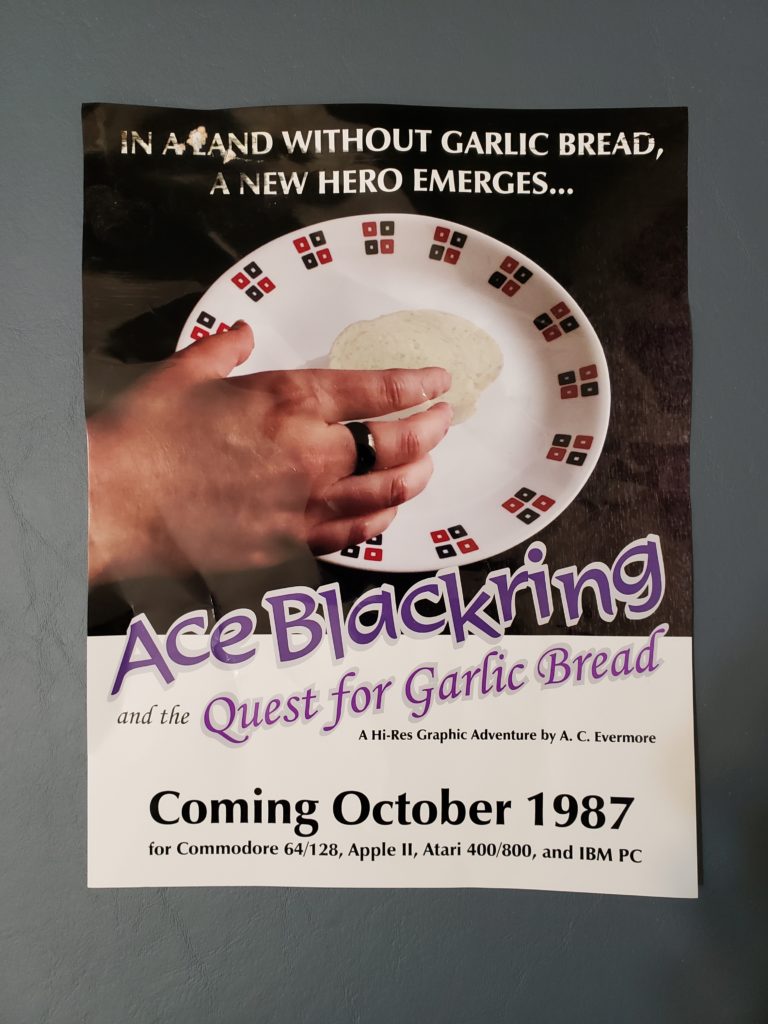
WHAT.
IS.
THIS.
I don’t think I ever “Buy It Now”ed something so fast. Three days later, it was in my hands.
From the tapemarks on the back, it looks like this was a promotional poster that was probably put in the front window of the store to advertise the game. It’s not the best looking poster in the world, but there was a lot of bad photography masquerading for game ads in those days, so I’m not going to hold that against it.
With a name like “Ace Blackring” and a mention of garlic bread, you’d assume it’s an asexual-themed game, but it could just be coincidental. After all, “Ace of Aces” isn’t a game about someone trying to out-asexual all the rest of the people and become the president of the local meetup group. But the picture solidifies it. Black ring, right middle finger. Clear as day.
So how come I’d never heard of this game? And how can I get a copy?
It’s not easy to research the history of video games that aren’t from our timeline. It took me two years of diving into archives, pestering collectors, and scouring old computer magazines to dig up enough material for this post.
One piece of information I already had: I recognized the name listed on the ad. A.C. Evermore was one of Terrace Spring’s most prominent authors, having written “You Are Asexual”, “The Quiver of Aros”, and “Queer Space Patrol”, among countless others. Each of these gamebooks sold dozens of copies. My research found that Terrace Spring tapped Evermore to write the new game, so that audiences would know that they were getting signature Terrace Spring quality. (Having read You Are Asexual and parts of Queer Space Patrol, “quality” would not be a word I’d use for what comes out of Terrace Spring, but anyway…)
The game is a graphic adventure. These days, that means a point and click game, maybe even a fully-rendered realistic 3D world, but in those days, it meant a text adventure with pictures. With well-known behemoths like Infocom and Sierra On-Line already firmly established in the space, Terrace Spring and Evermore were going to have an uphill battle. With that in mind, they decided to carve out a niche, as they had done with the Celebrate Your Own Identity series, and leverage the power of their existing audience.
The Celebrate Your Own Identity books were queer-themed multiple-choice gamebooks. Each one focused on a character of a particular identity. In “You Are Asexual”, you were an asexual student fighting the administration at a fascist high school. In “Mx. It Up”, you were a non-binary bar brawler. In “The Quiver of Aros”, you were an aromantic time-travelling cyborg archer trying to take down an evil corporation. The planned games would be similar, although slightly more covert in their queerness.
But what should the game be about? When executives at Terrace Spring planned the development and production cycle of the game, they came up with a target release date in the middle of October, and immediately had their theme. Mid-October would be perfect timing for the gift-giving season around Ace Week, or, as it was still known in those days, Asexual Acceptance, Understanding, and Empowerment Day, which was observed on the Thursday closest to 10/24. And thus, Ace Blackring entered development in January of 1987.
As far as I can piece together from the scanned copy of a partially revealed invisible ink hintbook, in the game, you play as “Ace Blackring”, who lives in a town between the old west and the high seas. The story seems to be that all the garlic bread in town was destroyed in a fire, and now you’re on a quest to find more. You have to deal with pirates and cowboys and “Sheriff Manatee”, who I think is actually a manatee. There are lots of ace jokes, like not being influenced by some sirens, or using a condom as a balloon. The game seems like it’s a mishmash of genres and time periods and from the outline I have, I can’t tell if it works or not. For that, I’d have to play it, and to play it, I’d need to track down a copy.
So what do you think I did next?
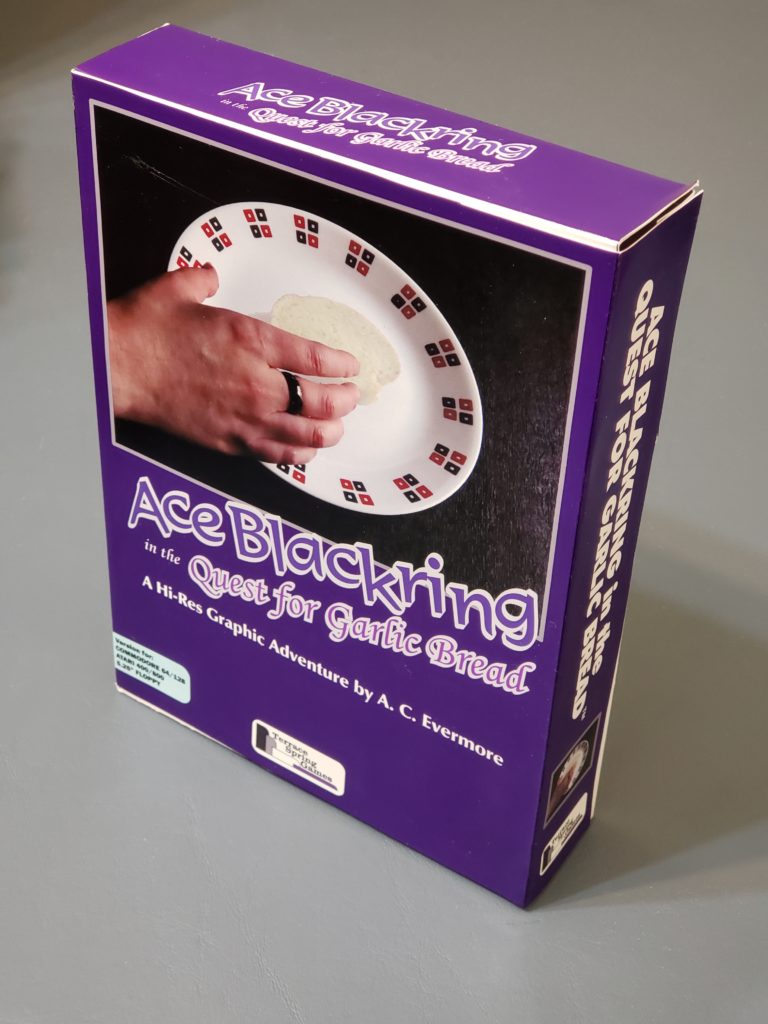
Here we are, 35 years later and beyond the boundaries of reality, but I finally managed to track down a complete, in box copy of this game! Check out that box art.
First, they reused the same photo from the ad for the cover. The hand reaching for a piece of ghost garlic bread doesn’t really grab me, you know? But there it is. And honestly, there have been worse pieces of cover art than this. Not many, but some…
The second thing to note is the subtle change in the title. The ad said “and the”, while the box says “in the”. I honestly don’t know whether that was an intentional marketing change, a mistake, or if this copy of the game found its way into our universe from a different reality than the ad. Either way, interesting to note.
This copy is for both the Commodore 64 and the Atari 400/800. Companies used to use this multi-format release technique as a way to save money and reach both markets. They wouldn’t have to worry about having different inventory for C64 vs. Atari, and customers would be more likely to find the copy of the game for their computer. (Well, except for the fact that most places that sold games for computers would separate the software by computer type, so it would’ve ended up on the shelf with either the C64 games or the Atari games and owners of the others would never see it, but whatever…) The Commodore 64, being the best computer, almost always was on Side A of the disk.
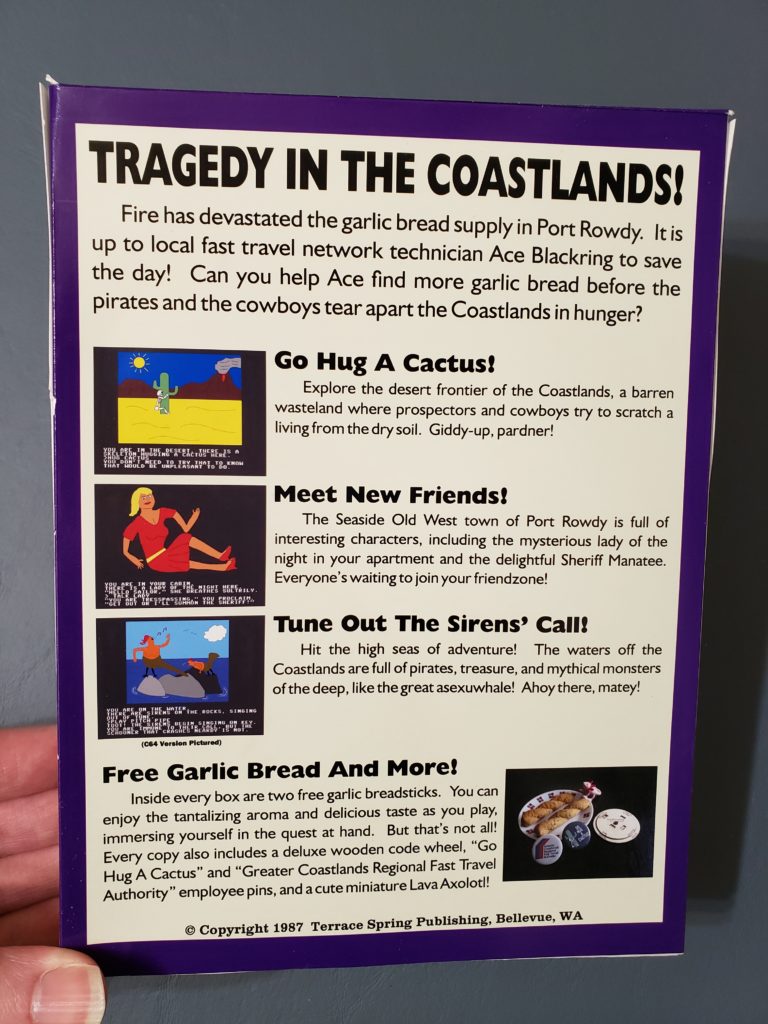
Tragedy in the Coastlands! A fire has destroyed all the garlic bread, and you embark on a quest to get more. Honestly, sounds like a better story than trying to rescue the princess from the evil wizard for the thousandth time.
And check out those graphics! Hi-Res indeed!
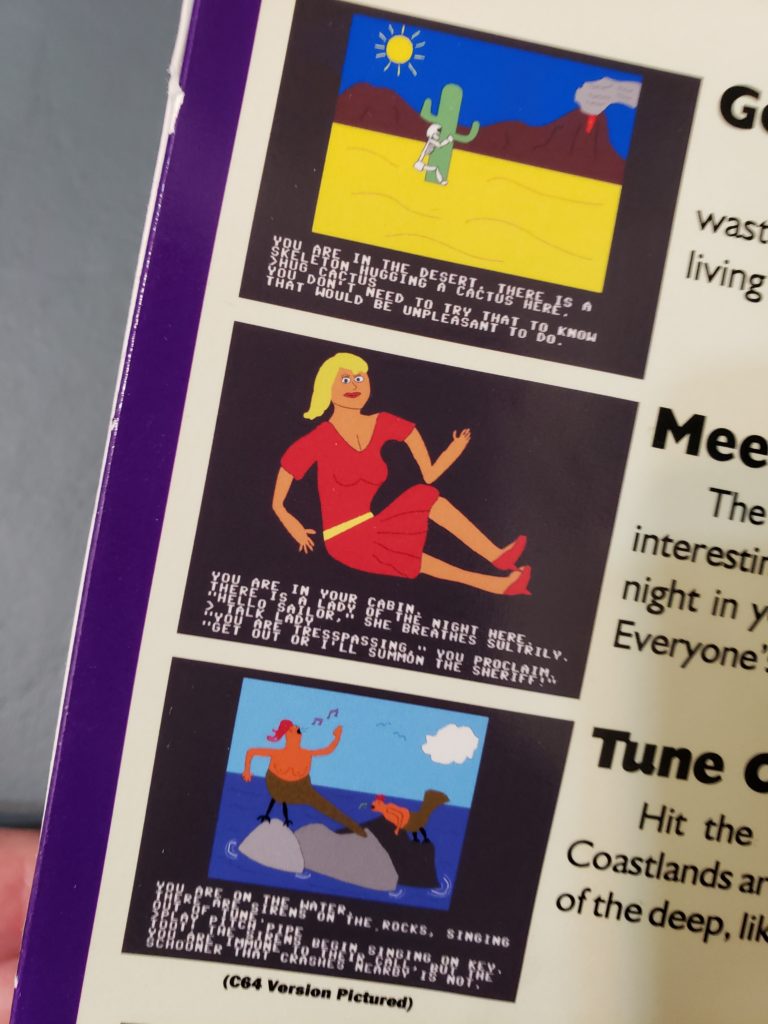
I’m going to have nightmares now.
Admittedly, graphics for many of these types of games were really really bad, because the tooling to support graphical design on these computers was really really bad. You could do some phenomenal graphics despite the technological limitations, but most games, especially adventure games, didn’t. Good graphics were hard to do and took up a lot of disk space, and when you have 50 locations to draw, sometimes with multiple states, that is a lot of work for not much gain. After all, much of the competition (like genre-leading Infocom) didn’t even have graphics at all.
But seriously, though, technology aside, what the hell even are those things on the bottom picture? They’re supposed to be sirens?
Anyway, enough of the outside, let’s open it up and see what lies inside.
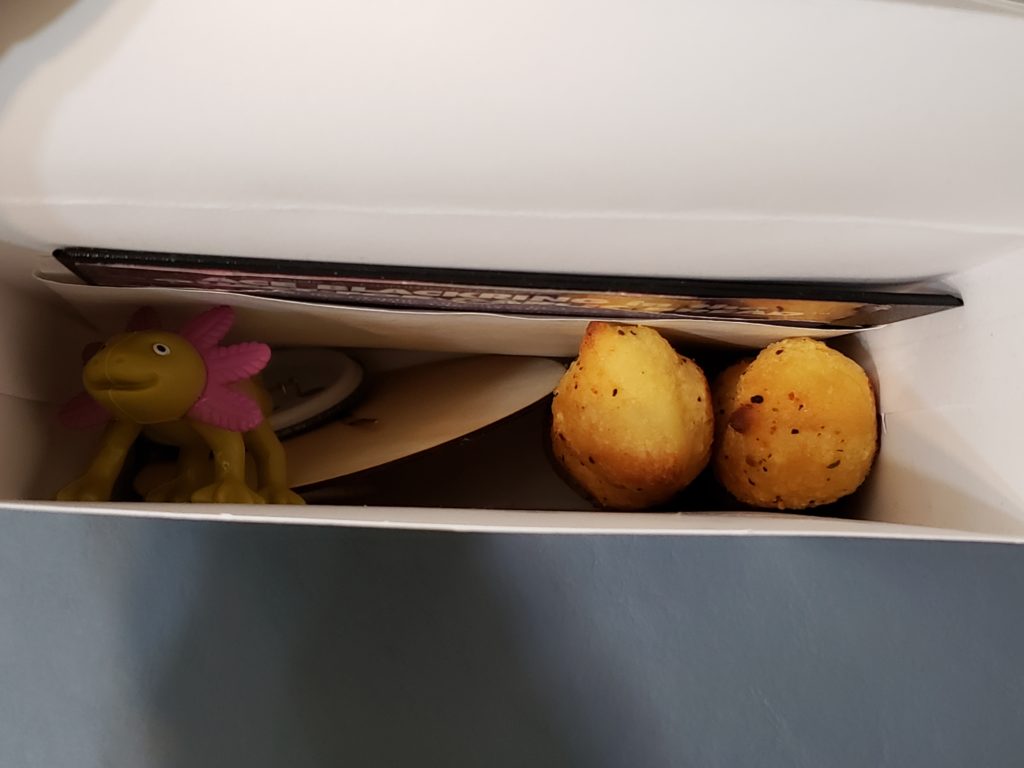
OMG. FEELIES!
I love feelies!
Feelies were a gimmick used by game publishers in the 80’s. Essentially, they were little Cracker Jack Toys (Cracker Jack still had toys back in the 80s, too.) inside the game box. They were meant to increase immersion and were sometimes used as copy protection, but usually they were just little toys. Let’s see what we have here…
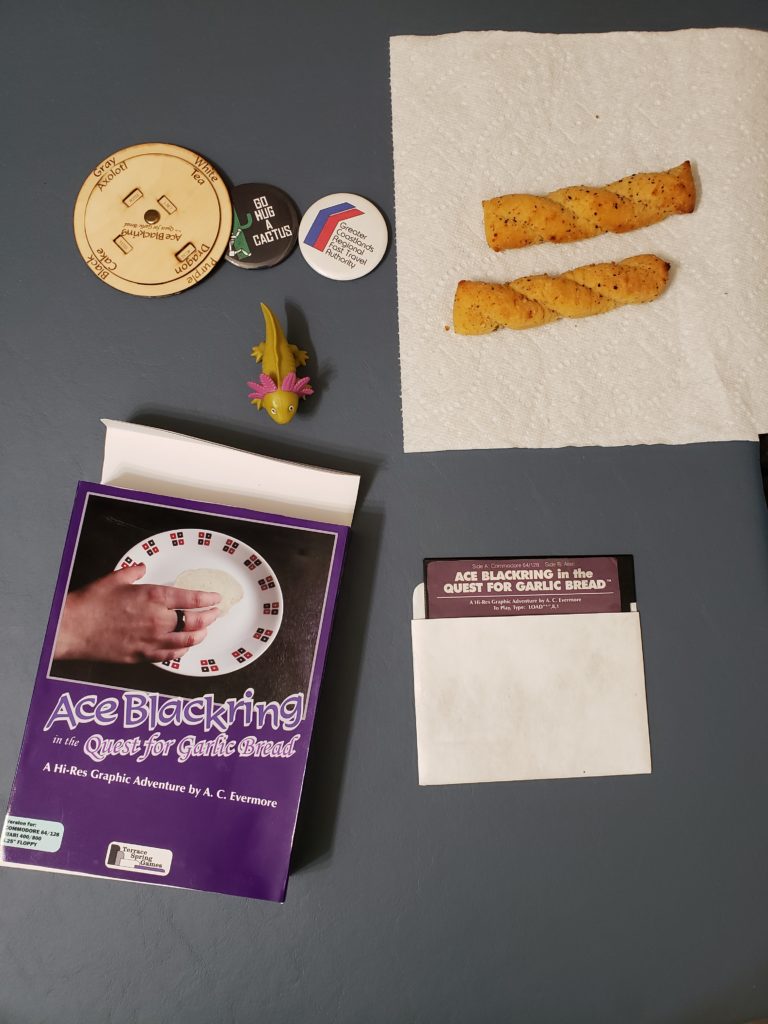
Okay, so first of all… GARLIC BREAD. This game came with GARLIC BREAD.
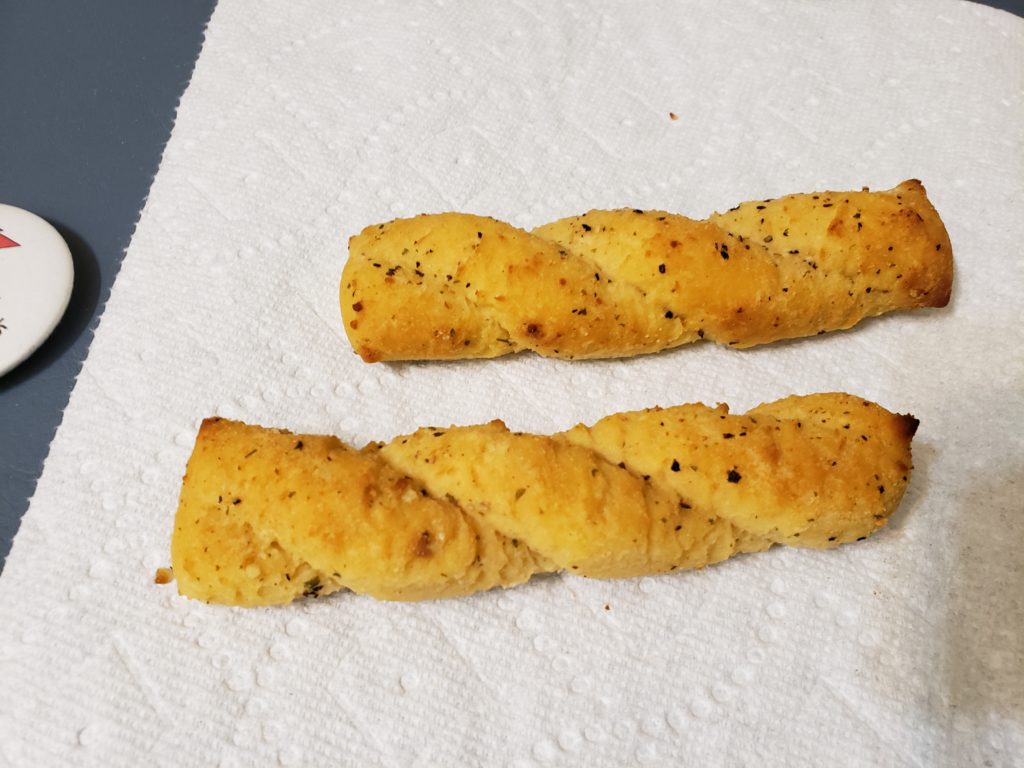
And that’s not some plastic or cardboard replica of garlic bread, it’s the real deal, two authentic, genuine garlic breadsticks. I honestly can’t decide if that’s the most awesome pack-in item ever or the most disgusting. They were just loose in the box, which is really weird. I’m honestly surprised the box and everything in it wasn’t stained beyond recognition after 35 years of touching garlic bread grease. I’d warm them up and let you know how they were, but they’re from 1987 (and from another universe), so I’m not gonna do that.
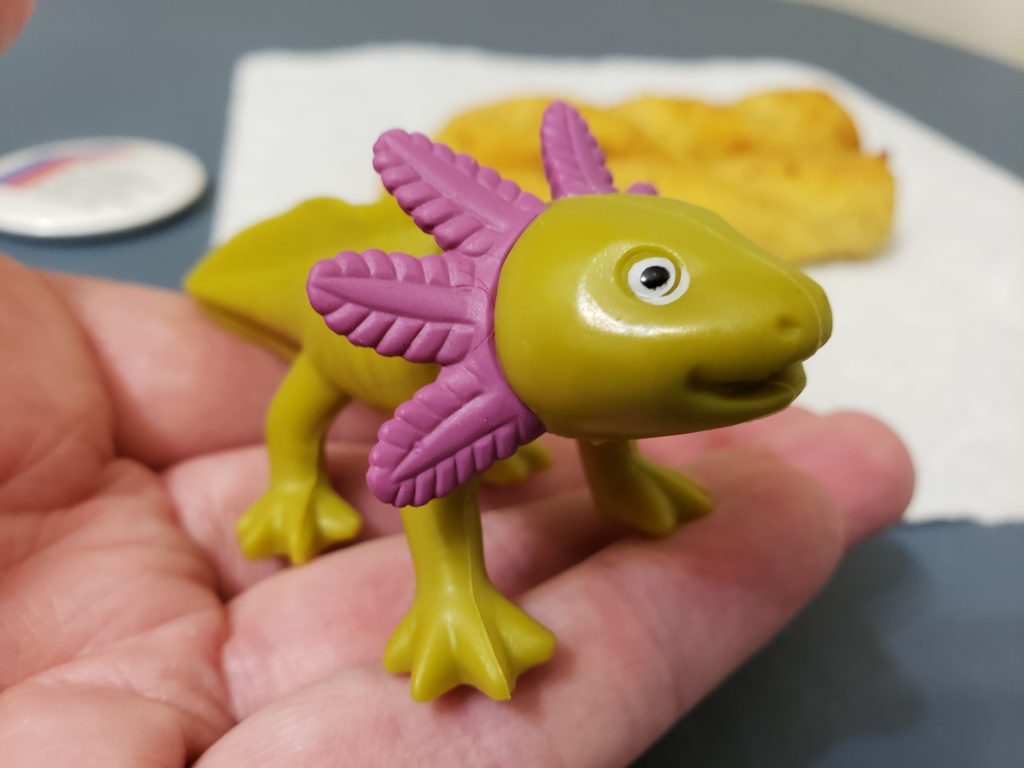
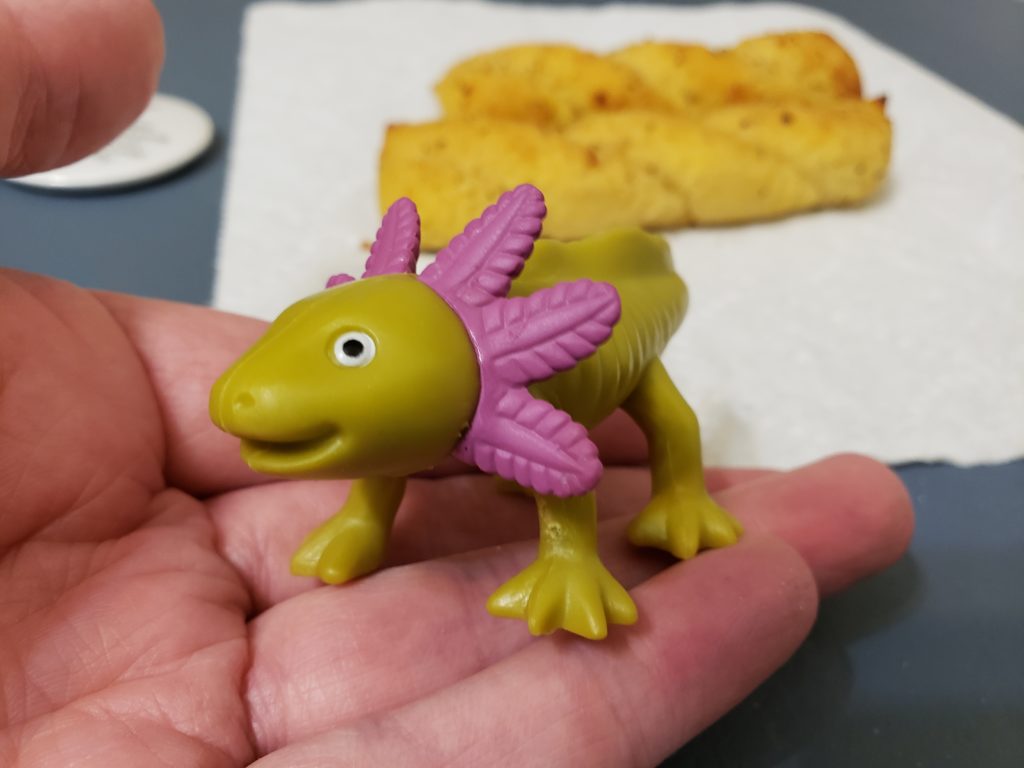
Next up is this cute little axolotl figurine. I’m not sure what it has to do with the game, but since it’s a feelie, it’s bound to be something important. The box called it a “Lava Axolotl”, but it doesn’t really look all that lava-y to me. The image on the box also showed a pink one, but I got one that’s green with purple fronds. I wonder how many colors there were and if there’s something special about each one. I’m gonna take this little friend into work and sit them on my desk.

There were also these two pinback badges. One features the popular “Go Hug A Cactus” command, inviting someone to do something that they know would be unpleasant without needing to try it. It’s fascinating that asexual meme culture produces the same results across time and space. The other button is for something called the “Greater Coastlands Regional Fast Travel Authority”, which I’m sure is something that would be exciting to someone who’s played the game, but I haven’t played the game, so I have no idea what that’s all about.
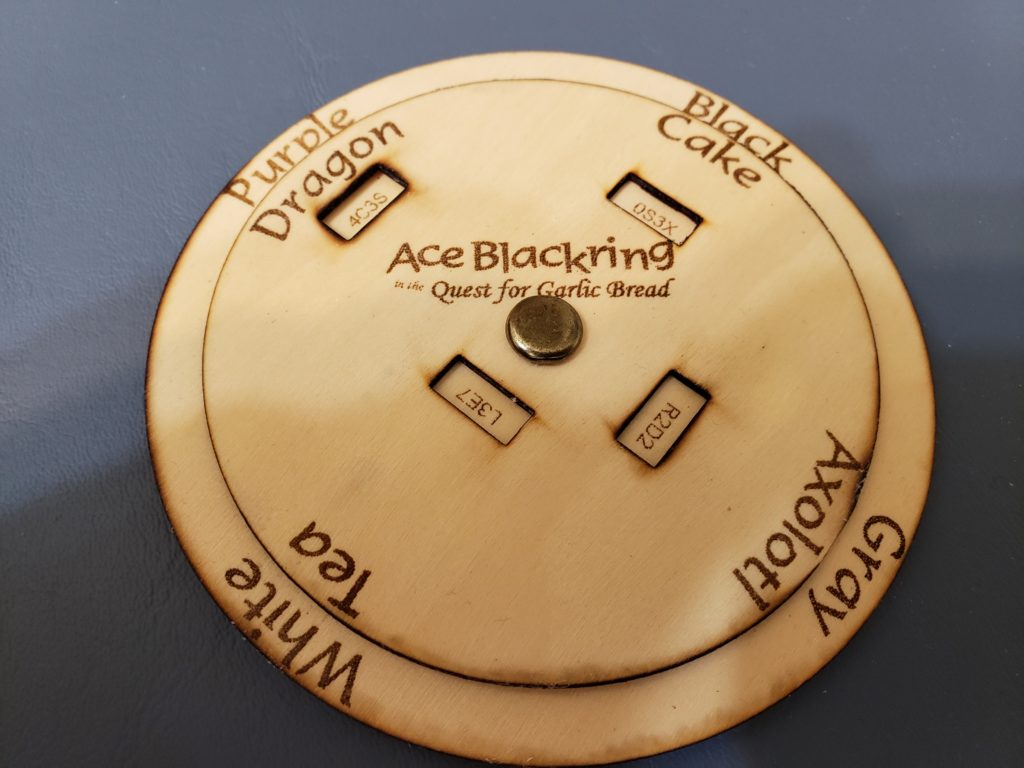
The last feelie is a wooden code wheel. Code wheels were a copy-protection mechanism employed by some game makers. They ensured that someone with a pirated copy of the game disk couldn’t play very far into the game. They were comprised of several independently rotating discs, with small windows in them. At some point in the game, usually fairly early on, there would be a prompt for a secret code using the wheel. For instance, the game might ask about a “Purple Dragon”, and expect “4C3S” in response, but if it asked for “Gray Tea”, you’d have to rotate and look up the code.
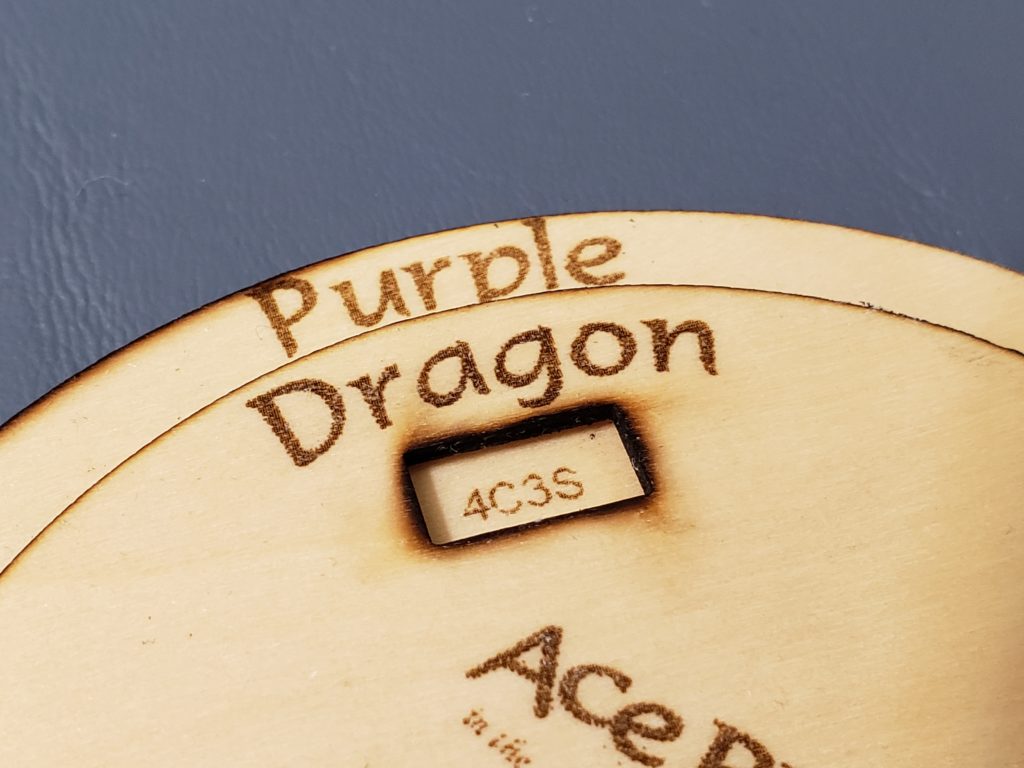
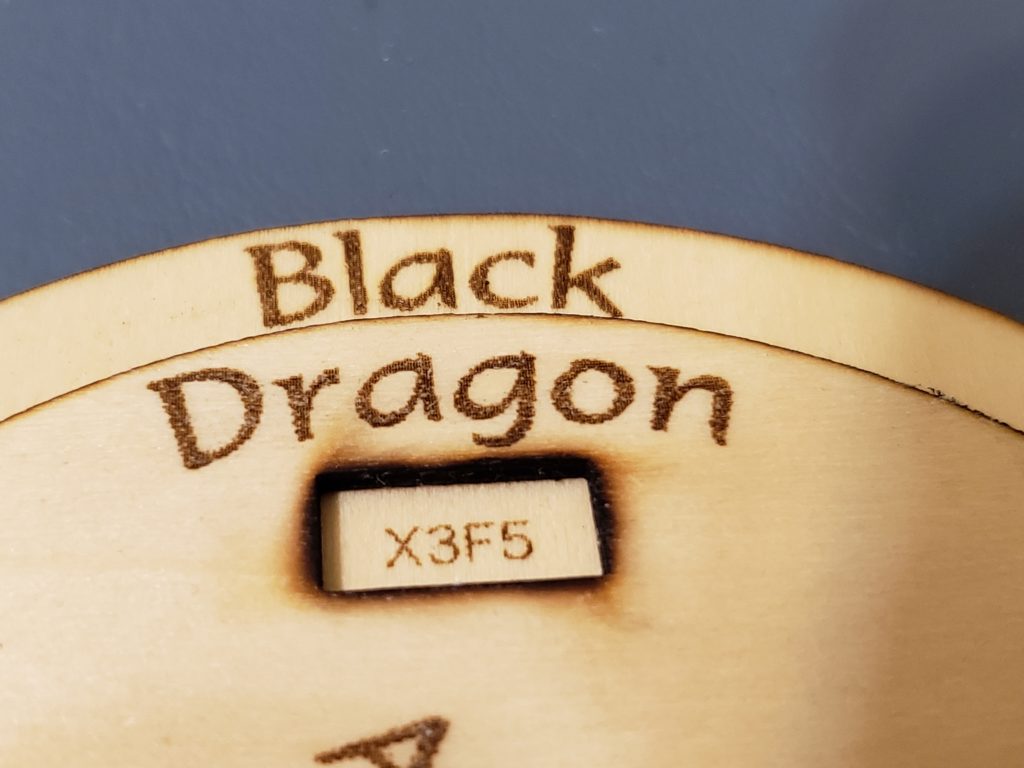
Usually, these code wheels were made out of cardboard. I don’t think I’ve ever seen one made out of wood before.
Unfortunately, this code wheel isn’t very complex. Most code wheels had dozens of options, with hundreds, if not thousands of combinations, making it difficult or impossible to provide a list of answers along with the copied disk. This one has a total of 16 options. That would be very easy to write down. Some people could even memorize the entire list. While it’s interesting as an object, it’s next to useless as an anti-piracy device.
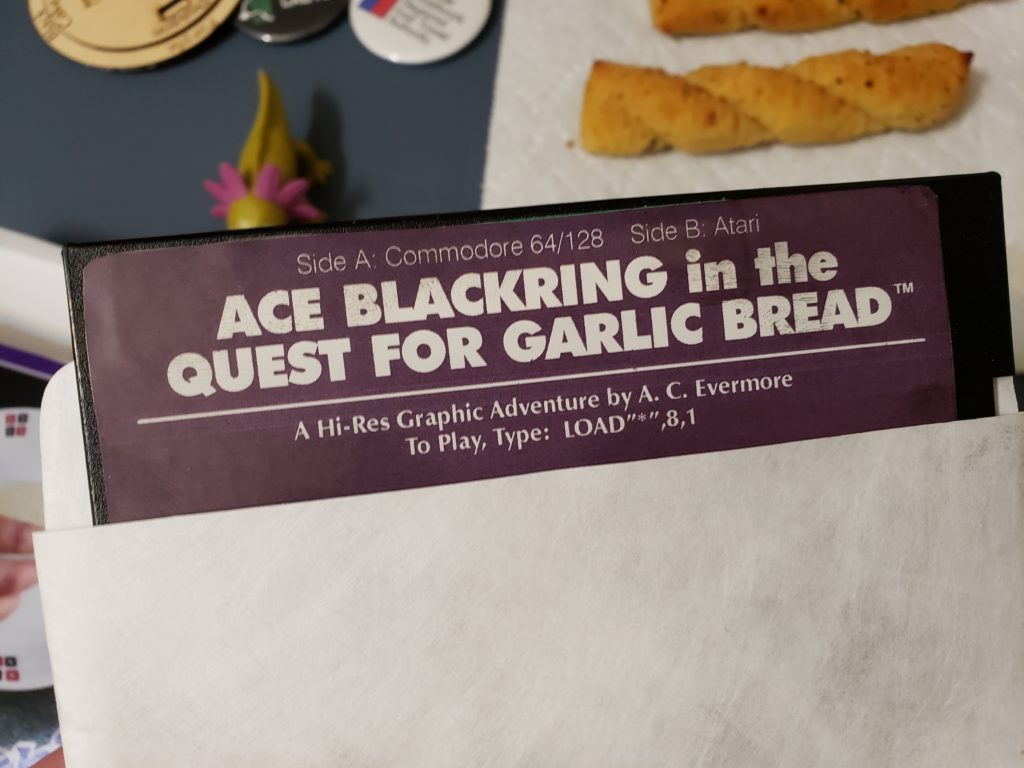
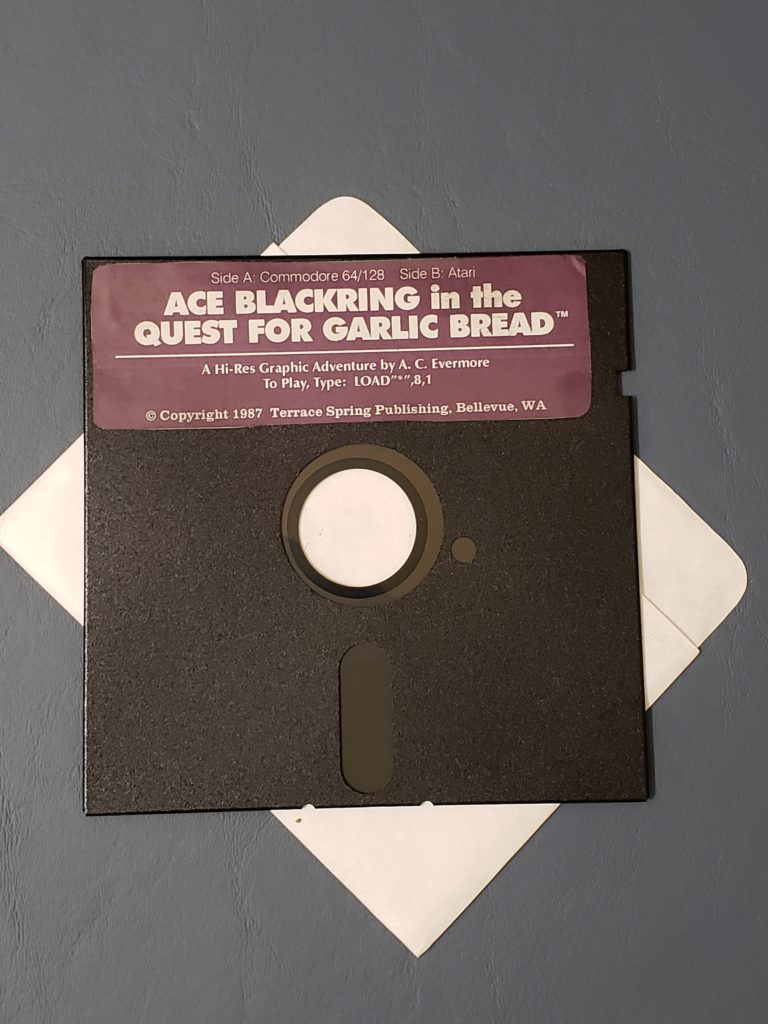
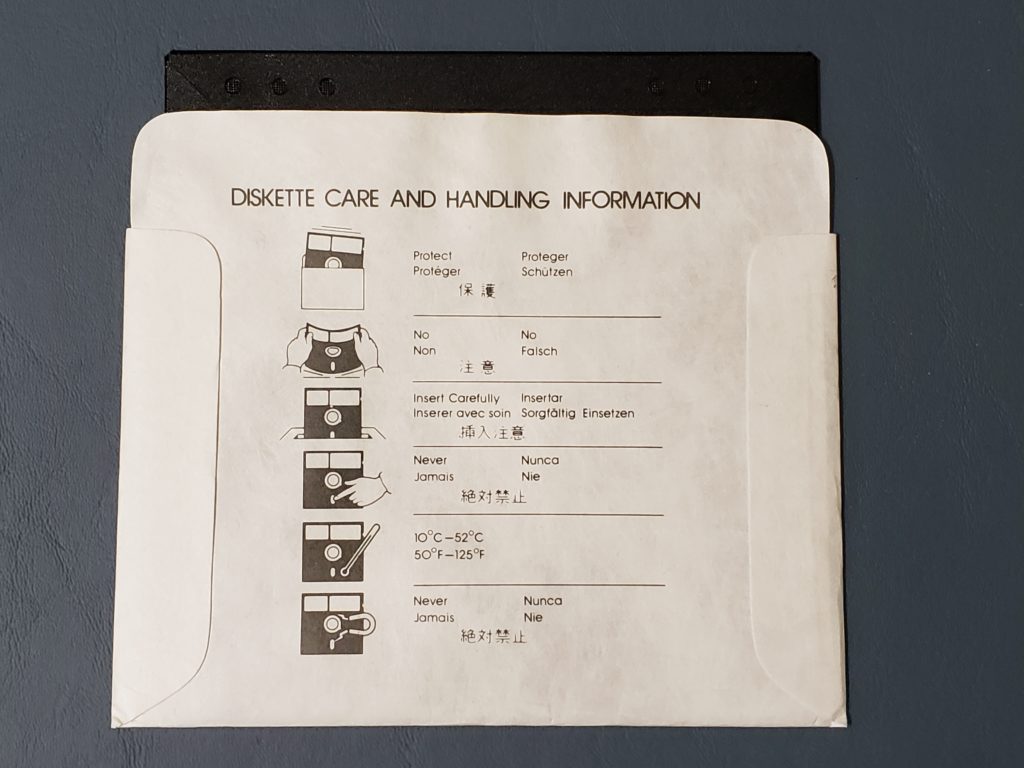
The final item in the box is the game disk. It’s a standard 5 1/4″ inch floppy, containing both the Commodore 64 version and the Atari 400/800 edition. If you’ve never seen a floppy, this is what they looked like. The envelope has the standard Rosetta Stone of Magnetic Media Dangers on the back.
This is the part of the post where I’d love to show you screengrabs and video from the game itself. I’d love to give a plot synopsis and dissect all the cultural references and marvel at the state of the ace community in 1987 and do all that stuff.
But I can’t.
I popped it in my trusty 1541-II, typed LOAD "*",8,1 as I’ve done so many times before, and…
Shhhshhhshhhshhshhh-crkcrkcrckcrk-shsh-crkcrkcrkcrk-shshshshshsh…
blinkblinkblinkblinkblinkblink.
Anyone who’s owned a Commodore knows the gut-wrenching horror of that sequence of events. The disk drive tries to read the disk, fails, makes a horrendous knocking sound, tries again, and then fails silently, the LED eternally blinking in despair.
The disk doesn’t work.
The back of the disk envelope doesn’t mention any dangers associated with interdimensional travel, but I’d imagine that whatever it was that brought this game to our universe probably involved a strong magnetic field.
The disk is frotzed. I can’t save the garlic bread.
Words do not begin to describe how disappointed I am.
My research indicates that Ace Blackring was the only game Terrace Spring ever released. I wonder if it’s because the game wasn’t any good or because all the fans were poisoned by that garlic bread. There are some references to a follow up game called “Quiver Arostone vs. the Onslaught of Amatonormativity”, but as far as I can tell, that didn’t exist beyond a vague “Coming Soon” promise on the Blackring’s warranty card. A.C. Evermore went back to writing the Choose Your Own Identity series, releasing the bestseller “What Is Love?” in February of 1988.
For years, asexual activism has been primarily focused on visibility and awareness. These are certainly important goals to have. You can’t do much of anything if no one knows who you are. And thanks to these efforts over the past twenty or so years, people do know who we are now. Large corporations include the ace flag in their Pride Month programs, major queer organizations will talk about Ace Week, even a fifth-term US Senator is using the “LGBTQIA+” version of the acronym now.
We’re visible now.
So what are we going to do next?
I certainly don’t want to claim that visibility work is complete and there’s no point in doing any more. Visibility and awareness continue to be worthwhile goals, and that will be the case until asexuality is as well known as the other orientations. But we can’t lose sight of the fact that visibility is just the beginning of our journey.
I’ve seen people say that they’re reluctant to get more involved in ace activism, because they don’t have a popular blog or a high follower count. This is a side effect of the hyper focus on visibility as the primary purpose of ace activism. After all, if you’re not popular, you’ve failed the visibility test, and since that’s all that matters, you can’t be a successful activist.
That attitude is wrong. On so many levels. Cast it aside and don’t even bother thanking it for its service.
Even in the visibility arena, activism can be successful at a small scale. Maybe you share one post about Ace Week, and your neighbor or your aunt or someone reads it and discovers who they are. It doesn’t require an audience of millions to make a difference.
But beyond that, there’s a vast world of activism that’s not about visibility and doesn’t use likes and subscribes as a measure of success. There’s some form of activism out there for all levels of experience and all different skill sets. And now that we’re visible, these are the things we need to be working on next.
That’s the point of this series. I want to touch on a number of post-visibility opportunities for ace activism. Some of these areas are almost entirely untapped, while others already have a number of people working on them. But all of them could use more people, doing more things. (And if you’re already doing any of these things or know someone who is, let me know and I’ll update the post to guide people in that direction.)
Also, I want to point out that although I’m largely positioning these as topics for asexual activism, many of them live in the intersection space with other kinds of activism. Notably, a lot of these topics are also going to be areas of aromantic activism or Single activism, and any work in these areas should keep those intersections in mind and strive to be inclusive where possible. I’m only focusing on the asexual aspects of these subjects because this is a series of posts on an ace-focused blog, specifically written for Ace Week.
And most importantly, these are opportunities for you, if you’re interested. I’m probably not going to be working on these, so if you don’t, no one will. You don’t have to be Important™, you don’t have to be Established™, you just have to be interested enough and driven enough to make it happen.
Ace Activism Opportunities:
[This is part of a series on opportunities for ace activism. See the masterpost here.]
We’re largely stumbling through life without a script. There aren’t role models to follow, coming of age movies with Important Lessons™ about us, there’s no body of precedent for how to life a successfully asexual life. We’re all cast upon the seas to find our own way, without even a “Good Luck!” to start us off.
How can I date if sex is off the table?
Can my marriage be saved?
I want to try sex, but I’m not sure how?
How do I deal with my nagging relatives?
What are my options for having children?
And most importantly, how in the hell do you build Ikea furniture by yourself?
There are hundreds more questions like these that aces ask every day: about relationships, about sex, about life in general.
But here’s the thing. There are enough of us who’ve been doing this for long enough, that there have to be some procedures and practices that work and some that don’t.
We should start collecting and collating and sharing that advice.
Now, I know there’ve been some bad asexual advice sources here and there, and it’s important to avoid the pitfalls and traps that they’ve run up against. But I think it can be done. I’m imagining something here that’s less “We’ll answer all your questions even if we don’t know the answers”, and more lifestyle magazine “Ten tips for shopping at Costco as a singleton” type articles.
[This is part of a series on opportunities for ace activism. See the masterpost here.]
I’m kinda burnt out and stressed about the election and everything else and don’t feel like writing this one.
…
There, that thought you just had. That one about “Yeah, I hear you” or “That sucks” or “Here’s 11 Weird Steps To Reduce Stress (You won’t believe #4!)” or whatever. That’s exactly what this needs.
Ace activists have a high churn rate. There’s burnout, there’s a constant deluge of hate and nonsense, there’s a sense that no one cares, there’s random people on Twitter who attack you for things they’ve flat out made up, there’s the never ending uphill climb, there’s the weight of the entire world on your shoulders because you’re the only one doing it all, there’s that other activist who you’re afraid to speak up about but you need to speak up about, there’s the going in circles forever and never getting anywhere… And on and on and on.
That needs to be fixed.
There needs to be some support network to break the cycle of burnout.
There needs to be someplace behind the scenes for activists to talk about what’s bothering them instead of it having to be aired publicly in a Twitter war.
There needs to be encouragement that what you’re doing matters.
There needs to be a shield from the hate.
It needs to be more than just affirmational little infographics and the other stuff that people call “support”. It needs to be something real.
[This is part of a series on opportunities for ace activism. See the masterpost here.]
As asexuality becomes more well known, groups of all sorts will want to make sure they are adequately meeting the needs of the ace community. There will be health care workers who will want to know what issues asexuals face. There will be educators who will want to know how to best cover asexuality in their lesson plan. There will be people making cartoons about talking horses who want to make sure that a character’s discovery of asexuality rings true. There will be lawmakers and lobbyists who want to make sure their new bills are inclusive. There will be HR directors who’ll want to make sure their corporate policies are ace friendly. There will be large queer organizations who want to ensure that asexuality is addressed in their programming from top to bottom.
Right now, these requests tend to go to whoever is the most visible. And the most visible person isn’t necessarily the best person for the job. Sometimes it’s not what they’re interested in doing at all. Sometimes they’re woefully unprepared for some of the issues that become important as they move further away from their typical zone of influence. And sometimes, they’re just way too busy.
I think there’s room for a group of consultants around asexual matters. People who have a clear grasp about the issues and can help translate what’s relevant for an external audience to integrate in their work. I think this sort of work could be an offshoot of a lot of the other opportunities I’ve already mentioned. I also think that this has a possibility of being a paid gig. People doing this would be providing a service and should be compensated. Maybe this is an independent group, but I can also imagine this work being done within larger organizations, perhaps as some sort of “Director of Aromantic and Asexual Affairs” within some major queer advocacy org.
[This is part of a series on opportunities for ace activism. See the masterpost here.]
For most of the other topics, I’ve talked about things that aren’t really happening to a wide extent. This is just the opposite. There’s offline ace organizing happening all over the place. Aces & Aros has a list of over a hundred groups doing this.
So why have I included it on this list?
Because there can always be more.
If you look at the map on Aces & Aros, there are huge areas that are vacant. There are aces in those empty spots, but no active local community or local resources for them. And even in areas with a strong local group, there is always room for more people. In the Seattle area, for example, most of our meetups are in the city itself, which is inconvenient or even impossible for people further out in the suburbs and surrounding areas. We’d benefit from hyper local organizers starting things in Everett or Bellevue or Bremerton or wherever.
Offline community organizing can take many forms. Hosting meetups. Being a mentor for a local school’s GSA. Organizing a Pride Parade contingent. Giving Asexuality 101 presentations at the library. And so on.
The benefits are uncountable. Basically every ace group I’ve ever been in has had people who’ve never met another asexual in person. Every time there’s a Pride Parade, there will be people who’ll turn out later, saying that’s how they learned that asexuality exists. And more than once, I’ve heard someone who’s moving wonder if there’s an ace group in the area they’re moving to, because they need the community support.
Having a strong offline presence can enable other forms of activism, too. Local activists have reached out to state governments to get recognition of Ace Week. Local activists have been contacted by television producers to help shape their portrayal of asexual characters. Local activists have worked to get asexuality included in sex ed programs at schools. And as we move forward, we’ll need local activists to push for things like legislative changes.
Content warning: This one talks about sex & stuff.
[This is part of a series on opportunities for ace activism. See the masterpost here.]
So, this topic is admittedly a weird one, and it’s one of the more nebulous subjects I’m covering in these posts. I don’t really know what the problem here looks like, exactly, but it’s something I’ve seen come up here and there. Or maybe it’s that the problem is clear, but I don’t have a sense of what solutions would look like? I’m not even sure what I should call this topic…
So anyway, the general idea of this problem is that there are a number of aces who are interested in doing sexual things of some kind, but don’t really have a way to approach or navigate that world. The standard ways and the common advice don’t always work here.
How do you safely find someone who will accept your level of interest or disinterest and respect your boundaries when you might not even know what those boundaries are yourself? How can you find someone willing to take part in a “test drive” or be willing to follow a strictly scripted scenario? Things like one night stands or hook-up apps are largely built around the premise that all parties involved have a generally equivalent desire to proceed with at least a common baseline of activities, and refusing to take part is sort of a breach of etiquette.
Or there are aces who really enjoy sex of all forms, but who don’t do the romantic relationship thing, but also don’t feel comfortable with the fling with a stranger thing, either.
I have seen many aces who are into nonsexual kink, but haven’t the faintest idea how to approach getting into in-person activities. They’ll often get blindly directed towards websites that aren’t an exact fit, and left without support.
I’ve seen complaints from people who are super interested in buying sex toys or kink gear, but are super turned off by all the other stuff they have to wade past in stores that sell it, whether online or not.
So much of the language used when talking about sex can be completely alien to many aces. That ranges from basic instructions to advanced tips, from toy reviews to relationship advice. Even just talking about what something is like can be wrapped in words and phrases that have no meaning.
There are even asexual sex workers out there.
And on top of all of this, there’s a cascading crush of stigmas and misconceptions and expectations that all slam down on asexual people who might be interested in sexual things. You’ve got the puritan side, which says that sex is bad, so you’re bad if you’re interested. You’ve got the free love side that sex is good, so you’re bad if you’re not interested enough. You’ve got the non-aces who think that an asexual person who has sex disproves the entire premise of asexuality, and you’ve got the ace people themselves who think that they’re making all asexuals look bad by having sex. And so on and so on.
Anyway, all of this is to say that there a problem here. Probably a number of problems here. And I don’t have the foggiest idea how to tackle them. (Ace meetup group field trip to a sex club? Cherry 2000 style sex robots? Legalized/decriminalized/destigmatized prostitution with an a la carte menu? I don’t know. All my ideas sound like plot starters for bad movies.) But it’s clear to me that there is room here for some ace activists to start dismantling and reshaping this area, to build spaces or come up with best practices on how to approach it.
[This is part of a series on opportunities for ace activism. See the masterpost here.]
For years, the focus of asexual activism has been around visibility and awareness. There’s been a lot of progress on that front, but it also feels like it’s a lot of just talking to each other. If you’re not in the right circles, it can still be difficult to discover asexuality. People who don’t know asexuality is a thing typically aren’t following ace activist Twitter feeds. And not everyone is surrounded by Zoomers who are In The Know about All Things Queer. Asexuality is still an invisible orientation for so many people.
So perhaps it’s time to work on more specifically reaching out to underrepresented population segments in our community, to find those missing aces where they are, instead of waiting for them to find us.
Reach out to BIPOC communities.
Talk to 40-somethings or give a presentation for a senior center.
Embark on an epic quest to uncover the lost city of ace men.
Find all the people who are still lost and broken because society has never shown them an alternative and bring them to us.
Each group will need a different approach. An Instagram infographic probably isn’t the best way to reach that 50 year old HR director, but an article in her celebrity gossip magazine might be. Compared to what we’ve done before, this sort of work requires a shift in technique. Someone needs to blaze that trail.
[This is part of a series on opportunities for ace activism. See the masterpost here.]
Right now, asexuality is mostly unrecognized in the legal world. In the US, only one state and only a handful of cities include explicit protection for ace people, and I’m not aware of the situation being any better elsewhere. There are countless laws and practices which unfairly affect ace and aro people.
So far, there has been little activism devoted to the area of legislation. In NYC, an ace lawyer helped author the explicitly ace-inclusive wording in that city’s Human Rights Law. There have been a handful of states where there have been symbolically meaningful, but legally meaningless proclamations where state governors have recognized Ace Week. And that’s about it. This is a huge area, with lots of opportunities for activists to make a difference.
One area that leaps to mind is anti-discrimination law. Federal Law does not explicitly cover sexual orientation at all. In states where there are anti-discrimination laws that do cover sexual orientation, most of them explicitly define sexual orientation in a way that excludes asexuality. (Only New York state explicitly includes it.) Asexuality is included in only a couple of city ordinances.
There is currently an effort underway to change the definition of sexual orientation in a proposed bill that will several federal anti-discrimination laws in the US. This is the first concerted effort of ace/aro political activism that I’m aware of.
But anti-discrimination law is just one piece of what needs to change. There are consummation laws that may require having sex for a marriage to be considered valid. Immigration interviews will ask extremely personal questions about bedroom arrangements. Asexual people are often targeted by conversion therapy. Tax law gives a discount to married people. Hate crime laws may not cover crimes against us. Inheritance law prefers spouses or blood relatives over “unofficial” life partners. Single people may be treated differently in health care situations. Many of these issues are not specifically “asexual” issues, but they will disproportionately impact asexual people. And this is just a subset of what can be worked on.
And legislation is just one way to change things. There are regulatory agencies or commissions who will set rules. There are court cases which will interpret laws and set precedent. Some of the most important civil rights victories have come through these avenues. Working with regulatory agencies would be a similar process to lobbying a congressional representative about a bill, but court cases would require plaintiffs or defendants, lawyers willing to take on the case, and likely a lot of money and a lot of time.
This is also an area that needs raw numbers of activists working on things. Changing a state law will require dedicated people working toward that goal in each state, so that’s at least 50 people if you want to make a difference everywhere. Changing a municipal code would require someone local to attend city council meetings, so now you’re talking about hundreds and thousands of people putting in the work.
These efforts would benefit greatly from the networking mentioned in a different post. If we coordinate our work with people who are already connected to the right people and who are already working on a similar area, then we have a greater chance of success. We need a network of ace politicians, ace lobbyists, and ace lawyers.